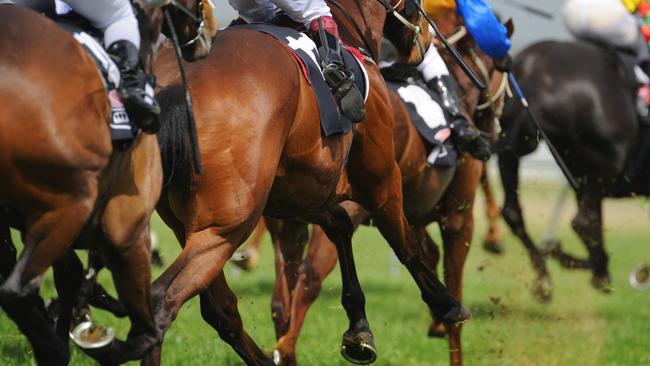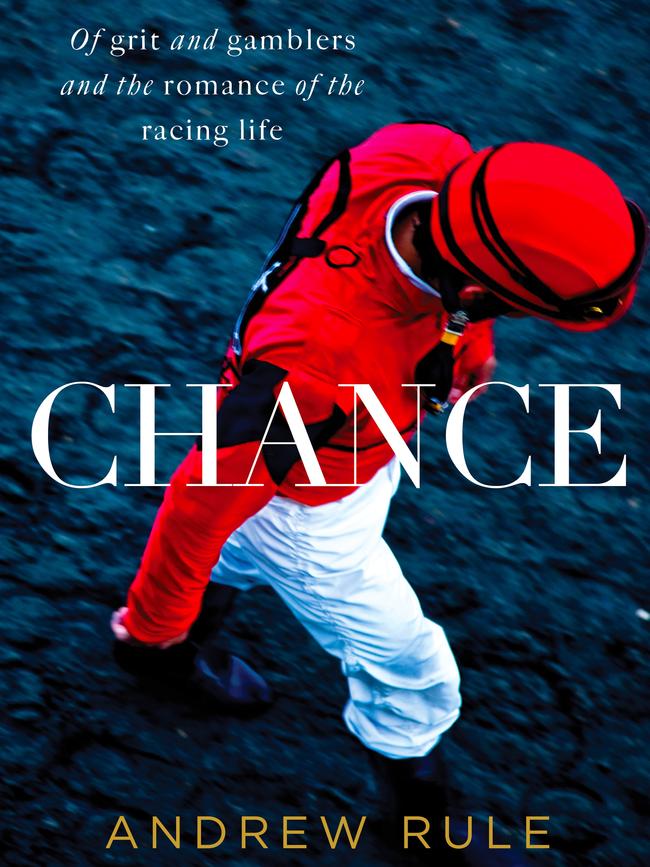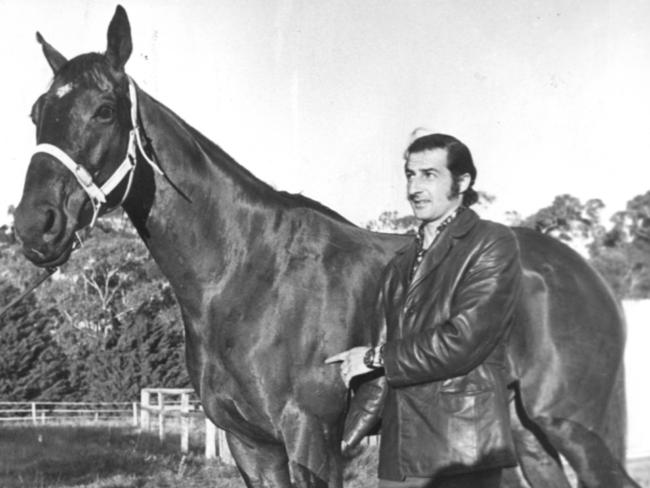Andrew Rule: Racetrack is where Shakespeare meets Sopranos
A wise man once said: “If you want to bet on numbers, go to a casino. If you want theatre, go to the races.” Racetracks have many stories and now certain people are gone, some can be told.
News
Don't miss out on the headlines from News. Followed categories will be added to My News.
In horse racing, they say no-one who owns an unraced two-year-old ever killed himself.
Floyd Podgornik shot that idea full of holes with a fancy Italian pistol in the bathroom of his penthouse in St Kilda Rd in the autumn of 1990.
“Floyd”, as everyone called him, was a high flyer in high-rise construction — and in racing, which he’d taken on with the zeal of the self-made tycoon.
By the time he pulled the trigger and ended it all, he had dozens of expensive yearlings stabled on a property high on a list of luxuries including his penthouse, Florentino restaurant, and multiple Porsches.
Even the horses’ pool was tiled Mediterranean blue like something in Portsea or Palm Beach.
He named the place Symbol Lodge and that’s what it was — a symbol of the fairytale success of the migrant kid who’d landed in 1963 with nothing but a cardboard suitcase, a hunger for work and a gambler’s nerve.
He’d started out pouring concrete all day and playing cards at night.
As a businessman, Floyd rode his luck.
In the 1980s, he was up there with Bond and Holmes a Court and the other boomtown billionaires.
When Wall St crashed in 1987, it took a while for the aftershock to hit Floyd and his mates, but there was no way to duck it.
As the sun set on 1980s excess, Symbol Lodge and its barns of expensive yearlings was just another millstone.
By the time Floyd reached for the pistol, barely one of his hothouse flowers had raced.
The week after his funeral, attended by both wife and mistress (and grieving builder’s labourers), one of his young horses won.
Then another, and another, until the trickle of success became a flood.
Symbol Lodge’s best horse, Centro, won the Caulfield Guineas and came within a stride of winning the Derby.
But it was all too late for Floyd, who died owing millions.

Just three years earlier he’d gutted the Sydney betting ring with a plunge on a horse called Knyf. That day he’d needed a suitcase to carry the bookies’ cash away from Randwick.
Now it was all gone, bar the memories. His ex-wife, the admirable Lorraine, now waited on tables she’d once owned.
The rise and fall of Floyd Podgornik, gambling man, is proof of the old racetrack saying: “The Punt giveth and the Punt taketh away”.
Damon Runyon shortened it to “All horse players die broke.”
Racing is full of shrewd people but no prudent ones, which is what makes it interesting.
As the late Les Carlyon once wrote, “If you want to bet on numbers, go to a casino. If you want theatre, go to the races.”
Les was right, of course. The track is where Shakespeare meets the Sopranos — with a touch of The Sullivans.
It has a million stories and now that certain people are dead and others in jail or paroled, some can be published.
I’ve gathered more than 20 insider stories for a book that goes public this weekend.
It’s called Chance. Anyone who thinks it’s Underbelly at trackside will find some evidence to make the case, but it is only partly about crime and rorts.
Racing is a broad church, and has its share of true grit, real romance and offhand decency to go with the needy, the greedy and the glitzy in a sport that underpins a gambling industry.
There is, for instance, the inside story of the Great Bookie Robbery of 1976, when a crew of well-drilled gunmen pulled a heist straight out of the Hollywood caper playbook.
The robbers used a “secret door” to get into the upstairs room of the Victorian Club on the only big day that armed detectives weren’t there to guard the cash. Funny about that.
The devil’s in the detail. When the gunmen made everyone lie down, tough old bookie Norm Cain got under the billiard table and hid his wallet and diamond ring.

Meanwhile, a sharp youngster, Con McMahon, lay behind the biggest man in the room, Wally Beaver. If bullets flew, he wanted a shield.
The police arrived late and never quite solved the robbery, although the book names one bent cop who might have got a slice of the action for running interference.
But not all robberies are pulled with guns. The book nails the backstory behind probably the greatest series of ring-ins pulled outside Queensland.
They were engineered by crooked car dealer Rick Renzella. Now, the jockey who rode for “Tricky Ricky” has revealed the truth behind legends that have grown around Renzella’s ring-ins for decades.
His name is Steve Wood. He was a handy apprentice jockey until Renzella’s scheming derailed his career.
The known part of the Renzella story is that he came unstuck with a brazen ring-in at Casterton in 1972, substituting the star sprinter Regal Vista for a third-rate bush galloper, Royal School.
The only resemblance between the two was they were both black.
When “Royal School” cruised around the field like a greyhound racing labradors, it had to be a rort.
He trounced the favourite, a local champion that only a city-class horse could match, let alone humiliate this way.
The local champ’s trainer, Jack Barling, was shaking with disbelief. But it wasn’t until the wise old trainer Jim Cerchi whispered that the winner was a “ringer” that Barling hollered for the stewards.
By then, on-course bets had been collected — including Cerchi’s.

The cagey old-timer had quietly backed the ring-in after noticing the horse had a big scar on his rump he knew was Regal Vista’s distinguishing feature.
Somehow, Renzella’s scam had leaked.
Someone apart from Cerchi had backed it on course, alerting others to follow the rush.
The plunging odds brought Renzella undone — but not until he had led the authorities a merry dance, spiriting Regal Vista from Casterton “into smoke”, hiding him in a chook shed while experts inspected poor Royal School, who was no help.
The key to Renzella’s rort was not doctoring brands but forging horse identity papers. It was good while it lasted.
Tricky Ricky was a career crook with a nasty streak and treated horses better than people. Young Steve Wood was wary of Renzella’s heavies: “Fred from Sydney” carried a gun, and that helped intimidate nervous small-time trainers to set up the stings.
Wood would later do jail time in Long Bay for running his own ring-ins. He had the bad luck to be charged with those just before the furore erupted over the Fine Cotton scam in Brisbane in 1984, which prompted authorities to throw the book at him.
Wood now verifies a long-held suspicion: Renzella had pulled a string of ring-ins before coming unstuck with the Regal Vista switch.
Wood was unknowingly initiated into the rort when he rode a supposed “hack”, Brianda Hall, at Bendigo on Caulfield Cup day, 1971.


It defied all expectations to win at huge odds — but was not backed on course and started at long odds, leaving stewards more perplexed than suspicious. Next day, at a boozy barbecue at Renzella’s Brighton house, Renzella slipped Wood a stack of cash.
Wood didn’t understand what had happened until a grinning Renzella showed him race photographs. One was of a city class galloper named Koda Pen. Then Wood realised it was actually the classy Koda Pen he’d ridden at Bendigo the day before, not Brianda Hall. Renzella had gathered several closely-related black horses that looked like each other.
Because of Renzella’s canny manipulation of the off-course TAB doubles betting market, he had scammed big money without alarms going off. Strange form reversals were forgiven if not accompanied by blatant betting plunges.
But greed and complacency took over. When Koda Pen broke down (running under another name) in Sydney and could no longer be the “stand in”, Renzella obtained the well-known Regal Vista to play the part — and came unstuck at Casterton. It was like using a film star to go shoplifting.
Before Renzella stood trial, Jim Cerchi’s horse truck was shot at on the highway by a mystery man in a passing car. Steve Wood thought it was probably “Fred from Sydney”, sending a message about giving evidence.
When the judge asked Cerchi if he thought the humble Royal School was really the horse that won at Casterton, the old trainer said, deadpan: “Your Honour, it looked bloody like it to me.”
Cerchi the bush lawyer had slipped the punch perfectly.
A decade after Renzella went to jail, the Fine Cotton saga played out in Brisbane in a way that made ring-ins look somehow comical. But the reality behind the cheap laughs was that cold-blooded criminals were willing to murder people used as pawns in setting up “sure things” to launder black money via winning bets.

Sydney race fixers like George Freeman and “Big Bill” Waterhouse had their own corrupt networks, nobblers and enforcers to rig races in the eastern states. Perth racing had its own crooks.
As revealed in News Corp outlets this weekend, it was Waterhouse’s “attack dogs” who tortured and murdered horse trainer George Brown in Sydney in early 1984 when he failed to go through with a ring-in as ordered.
The likes of Freeman, his murderous associate Lennie “Mr Big” McPherson and the Machiavellian Waterhouse had tentacles in three states, if not four.
The story of how Waterhouse earned the lifelong hatred of legendary trainer Bart Cummings by drugging Melbourne Cup favourite Big Philou in 1969 is one of many.
The wily Cummings got his revenge years later and within the rules: he told Waterhouse his champion mare Leilani was not fit enough to win a certain race, luring him into accepting huge bets on her. She won, costing the bent bookmaker a fortune.
“What was that for?” an enraged Waterhouse snarled at Cummings after the race.
“That was for Big Philou,” said Cummings.
The highs are huge at the track. Kev Cain — ex-jockey, ex-bookie, ex-trainer and dedicated punter — turned $6 into $86,000 at Caulfield one afternoon in 1978. He jokes that he spent most of it on wine, women and song … but wasted the rest.
There’s the inside story of international tennis stars Lew Hoad, Jack Kramer and “Lucky Ted” Schroeder pulling off the biggest win of their careers from a boat on Sydney Harbour, plunging on a South Australian farmer’s horse at Canterbury races.
There is the court case over a biscuit tin full of “black” cash that builders dug up under a house previously owned by a leviathan bookie.
The bookie pretended the cash wasn’t his to avoid prosecution for tax evasion, but kindly offered to take it anyway. His ex-wife claimed her late father-in-law had buried it for her after a big win. The builders said it was clearly a case of “finders keepers”.
The judge dismissed them all and gave it to the migrant family who’d bought the house just before the cash was dug up. Their name was Schindler, which is why the story is called Schindlers’ Loot.
The buried treasure was £8500 — more than the Opera House lottery prize in 1965, and enough to buy a suburban house. If that’s what the Schindlers did with the windfall, the house they bought would be worth millions now.
All punters die broke. But the Schindlers didn’t even have to buy a lottery ticket, let alone have a bet. That’s chance for you.
If you are experiencing suicidal thoughts or need other mental health support contact Lifeline on 13 11 14 or lifeline.org.au
CHANCE: of grit and gamblers and the romance of the racing life. By Andrew Rule. Pan Macmillan. RRP $34.99





